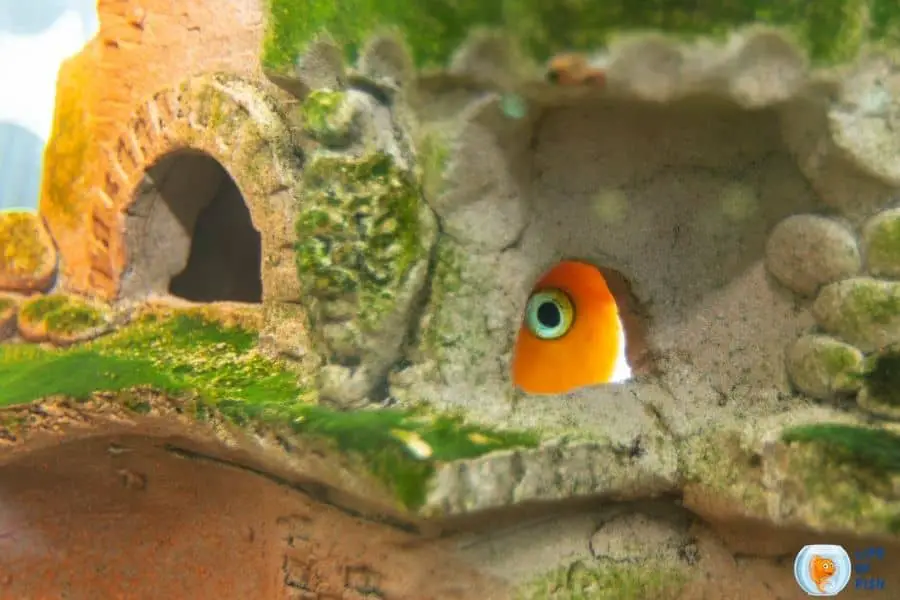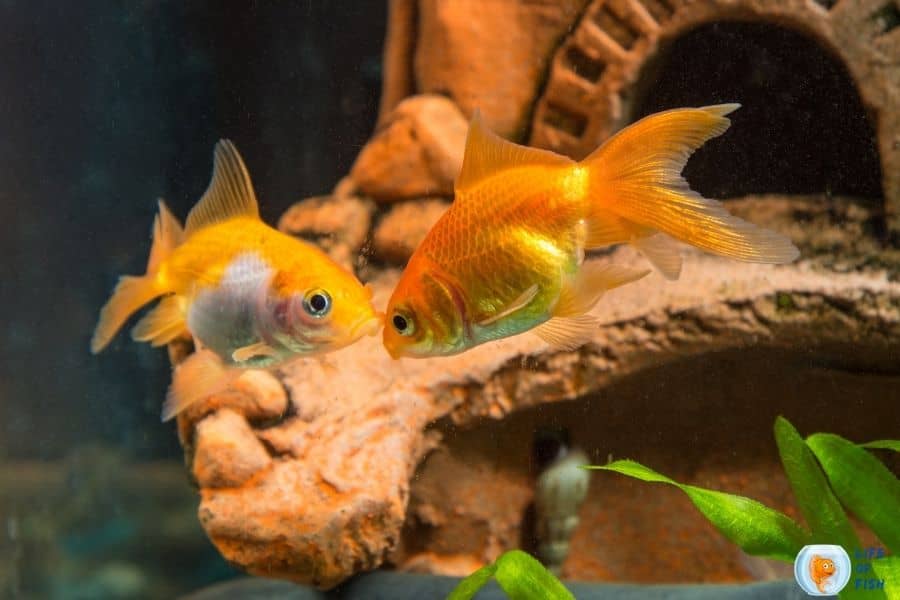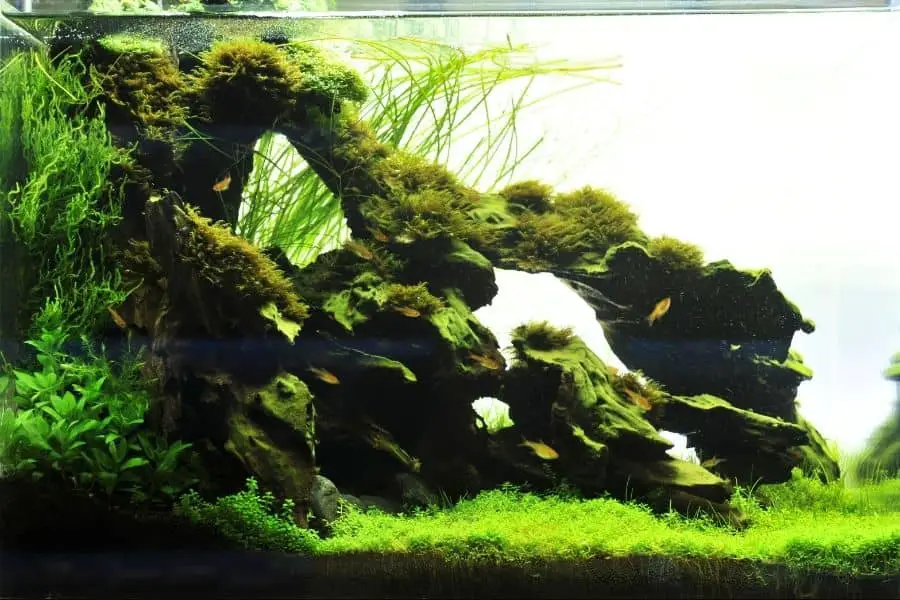Caves bring an aquarium a unique look as well as a nice hiding place for your fish. However, they can be expensive to buy or difficult to modify into other shapes. For small-scale aquariums, buying a small DIY aquarium cave would be an affordable option. But with the popularity of large aquariums, caves are hard to buy. The solution? Build your own!

Do fishes need caves?
Jump To
This is an obvious question every beginner would ask. Do fish need caves? Well, that depends on the fish type, size, and temperament level.
Often aggressive fish species do not need caves because they are inclined to fight if they have a cave as a hiding place. So, be careful when you plan to use caves for aggressive fish species.
On the other hand, peaceful fish species prefer caves for hiding when they feel threatened or stressed.
A cave is required if you house peaceful fish with aggressive or semi-aggressive fish species. Otherwise, peaceful fish will get bullied by other fish.
When you keep large fish with smaller fish, small fish need a safe place to hide when they feel frightened or threatened. You can install caves that will provide hiding spots for the small fish while the larger fish might not fit in.
Generally, caves are required for smaller fish species, requiring extra hiding places.
Some fish species are used to living in caves, such as black widow tetra and Mexican blind cave tetra. So, if you plan to keep these fish in your aquarium, you must add caves.
However, most schooling fish won’t need caves. Examples are guppies, swordtails, platys, mollies, neon tetra, etc.
So, before adding any cave to your aquarium, research your preferred fish a bit because your fish might not need it. But, most fish do need caves.
What types of caves are available at pet stores?
There are many types of caves available at pet stores. The most common type is plastic caves made of hard plastic.
These caves are normally shaped like small tubes with holes and small openings. Another type is natural caves, which come from limestone and consist of various shapes and sizes.
Natural caves made of limestone are expensive and can cost a lot. However, they look more natural and fit into most aquariums without any problem.
In addition to limestone caves, there are some other types of caves that are made of resin, stone, or ceramic.
Resin is heavy but relatively cheaper than limestone. Resin caves are also lighter than calcareous caves. Since resin is not porous, you need to fill the holes with sand or gravel. You can easily remove them later using a pair of long-nose pliers.
Ceramic, stone, and honeycomb caves are porous, so you need to use epoxy resin to seal the holes.
Why build your own if you can buy one?
Now that you know that there are many types of caves available at pet stores, why should you bother building your own?
Let’s take a look!
It is a lot easier for beginner aquarists to build their own caves instead of buying one. There are many risks involved when you try to modify an existing cave. The least risk is breaking off the open end of the cave, which will be hard to seal.
Another important reason is that you get the freedom to create your own design. You can modify the shape of the cave, drill holes and even add epoxy resin to make it more durable.

What to consider before building a cave?
Before you start building your own cave, there are a few important things to consider before you get started.
The materials you use to build the cave
The material you use to build the cave defines its appearance, weight, durability, and cost.
It is very important to pick a suitable material for you and your aquarium water. For example, if the material is porous, it will alter the water’s pH balance.
If you use heavy material, it will remain sank. But, sometimes, you may need lightweight caves for some reason. Several materials are suitable for building lightweight caves.
These include coconut shell caves, resin caves, PVC piping, etc.
Once you have decided the material you will be using to build the cave; it is easy to get started with the process of creating your own cave.
The size of the cave
You should keep in mind that bigger caves are better than smaller ones. When you build a cave, it is better to make it large enough to fit in most fish species.
This is important because you might end up buying another fish with a different shape or size.
On the other hand, you should not build a too large cave that doesn’t fit into your aquarium. It will take up a lot of space and create a lot of unnecessary mess in your aquarium.
The type of glue to be used
For building caves, epoxy resin is the best type of glue to use. Since it has strong adhesion properties, you can easily build your own caves using epoxy resin.
Now you know about the process of building your own caves, let’s get started!
Aquarium cave ideas
While you can DIY aquarium caves with lots of materials, here are some aquarium cave ideas to get you started.
Clay caves
Aquarium caves made out of clay are easy to make. All you need is dough made of clay, a stick for rolling into shape, and lead-free ceramic paint in your desired color.
Alternatively, you can also use cookie cutters to shape the dough before baking it.
After baking, apply lead-free ceramic paint or epoxy resin to get a shiny finish.
Ceramic caves
You can also create an aquarium cave using ceramic or earthware pottery or flowerpots.
Clean the inside and outside of the pot thoroughly before you start carving the cave.
Start by making a bowl-shaped inverted pot, use a knife to remove the extra clay, and attach a string for hanging.
After that, use epoxy resin or lead-free ceramic paint to seal and for finishing touches of the cave.
Once fully dry, start shaping or decorating it as your desired design.
Finally, you can add a layer of epoxy resin to seal the design and protect it from water.
Coconut caves
One of the easiest and most readily available materials you can use to build your own caves is coconut shells.
You can drill holes and attach strings for hanging before painting it with epoxy resin or ceramic paint.
You can decorate it further by adding a layer of epoxy or ceramic paint.
Slate (shale) caves
Slate is another easily available material you can use to create aquarium caves.
Once you have obtained a piece of slate, smash it into pieces. Now stack the small pieces into a shape of a cave.
Then use epoxy resin to strengthen the pieces. You can also add gravel to make things more attractive.
PVC caves
Aquarium caves made of PVC pipes can help you create an amazing underwater feel in your aquarium.
Start by cutting the pipes into desired shapes and sizes. Afterward, you can use epoxy resin or ceramic paint to add color and shine.
You can also add gravel and decorations like artificial plants, driftwood, etc.
Resin caves
You can also make resin aquarium caves using epoxy resin. Once you have obtained your desired shape, use epoxy resin to make it more natural.
After it is fully dried, you can use epoxy resin in the desired color or paint it according to your aquarium theme.
Natural rock cave for aquarium
These caves are probably the cheapest option if you are on a tight budget. Natural rocks are readily available from just about anywhere.
They also make great focal points in your aquarium and can help create a stunning natural appeal.
You can choose to use them as they are or stack them up in a cave shape to make things more interesting.
Also, drill holes and add gravel to make them more beautiful. You can also paint them in different colors or in your aquarium theme.

DIY cichlid caves
Cichlids, especially African cichlids, are very territorial. These fish pick out a cave and make their territory.
If any other fish tries to move in, then these fish become very aggressive.
If you keep more than one cichlids, you must add more caves in your aquarium to avoid aggressiveness.
Since cichlids love rocks, the best types of DIY cichlid caves are caves made with rocks. You can, however, use any other type of materials, but rocks are the best available option.
Maintenance of aquarium caves
Caves are an important part of the aquarium decoration. Apart from being an excellent home for your fish, they also create a natural environment for them.
You should regularly clean your aquarium and the caves to prevent dirt from accumulating over time. Also, make sure you clean the caves before moving or rearranging them.
If you have a gravel substrate, you should regularly check for wastes and remove them to ensure proper water quality.
You can also create multiple caves and move them around as you please. This will create a more natural and attractive layout for your fish.
In case the cave has a crack or has got damaged, you can fix it by applying a strong adhesive and letting it dry for a couple of hours.
Final Thoughts
DIY aquarium caves can transform the look of your aquarium entirely. They are fun and easy to make and create a very natural-looking environment for your fish.
The key is to choose the right material that will give your aquarium a natural look and last long. You can start by making simple caves or go for more complicated ones depending on your likings and budget.
Easily available materials like rocks, PVC pipes, and slate can be used to make a beautiful-looking piece of aquarium decoration. Try out different ideas and decorate your aquarium with a customized layout.
Let us know in the comments which one of these DIY caves you decided to make. Also, if you have any other ideas for making cave decorations for your aquarium, share them with us.
Read Next : Best Solar Pond Pumps (What is the best type of pump for me to buy?) Fish At Top Of Tank After Water Change | And 6 Other Interesting Facts | Aquarium Lava Rock | Rock Solid Facts About Benefits And Drawbacks |
